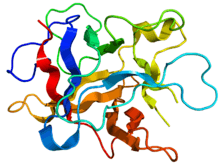Kunitz STI protease inhibitor
Kunitz soybean trypsin inhibitor is a type of protein contained in legume seeds which functions as a protease inhibitor.[2] Kunitz-type Soybean Trypsin Inhibitors are usually specific for either trypsin or chymotrypsin. They are thought to protect seeds against consumption by animal predators.
| Trypsin and protease inhibitor | |||||||||||
|---|---|---|---|---|---|---|---|---|---|---|---|
 Structure of a Kunitz-type trypsin inhibitor.[1] | |||||||||||
| Identifiers | |||||||||||
| Symbol | Kunitz_legume | ||||||||||
| Pfam | PF00197 | ||||||||||
| InterPro | IPR002160 | ||||||||||
| PROSITE | PDOC00255 | ||||||||||
| SCOPe | 1tie / SUPFAM | ||||||||||
| |||||||||||
Background
Two types of trypsin inhibitors are found in soy: the Kunitz trypsin inhibitor (KTI) and the Bowman-Birk inhibitor (BBI). KTI is a large (20,100 daltons), strong inhibitor of trypsin, while BBI is much smaller (8,000 daltons) and inhibits both trypsin and chymotrypsin.[3] Both inhibitors have significant anti-nutritive effects in the body, affecting digestion by hindering protein hydrolysis and activation of other enzymes in the gut. In soy, KTI is found in much larger concentrations than BBI is soy, however, to achieve the highest nutritional value from this ingredient, both of these inhibitors must be denatured in some way. Whole soybeans have been reported to contain 17–27 mg of trypsin inhibitor per gram.
Structure
Proteins from the Kunitz family contain from 170 to 200 amino acid residues and one or two intra-chain disulfide bonds. The best conserved region is found in their N-terminal section. The crystal structures of soybean trypsin inhibitor (STI), trypsin inhibitor DE-3 from the Kaffir tree Erythrina caffra (ETI)[1] and the bifunctional proteinase K/alpha-amylase inhibitor from wheat (PK13) have been solved, showing them to share the same beta trefoil fold structure as those of interleukin 1 and heparin-binding growth factors.[4]
Despite the structural similarity, STI shows no interleukin-1 bioactivity, presumably as a result of their primary sequence disparities. The active inhibitory site containing the scissile bond is located in the loop between beta-strands 4 and 5 in STI and ETI.
The STIs belong to a superfamily that also contains the interleukin-1 proteins, heparin binding growth factors (HBGF) and histactophilin, all of which have very similar structures, but share no sequence similarity with the STI family.
Action and Consequences of Trypsin Inhibitors
Trypsin inhibitors require a specific three-dimensional structure in order to follow through with inactivation of trypsin in the body. They bind strongly to trypsin, blocking its active site and instantly forming an irreversible compound and halting digestion of certain proteins. Trypsin, a serine protease, is responsible for cleaving peptide bonds containing carbonyl groups from arginine or lysine. After a meal, trypsin is stimulated by cholecystokinin and undergoes specific proteolysis for activation. Free trypsin is then able to activate other serine proteases, such as chymotrypsin, elastase, and more trypsin (by autocatalysis), or continue breaking down proteins.[5] However, if trypsin inhibitors (specifically KTI) are present, the majority of trypsin in the cycle of digestion is inactivated and ingested proteins remain whole. Effects of this occurrence include gastric distress, and pancreatic hyperplasia (proliferation of cells) or hypertrophy (enlargement of cells).[6] The amount of soy inhibitors is directly related to the amount of trypsin it will inhibit, therefore a product with high concentration of soy is suspect to produce large values of inhibition. In a rat model, animals were fed either soy protein concentrate or direct concentrate of the Kunitz trypsin inhibitor. In both instances, after a week the rats showed a dose-related increase in pancreas weight due to both hyperplasia and hypertrophy.[6] This indicates that long-term consumption of a diet high in soy with strong trypsin inhibitor activity may produce unwanted effects in humans as well.
Inactivation of Trypsin Inhibitors
A significant amount of research is being done to determine the best method of inhibitor inactivation. The most successful methods found so far include:
- Heat
- Freezing
- Addition of Sulfites
Cancer Research
While trypsin inhibitors have been widely regarded as anti-nutritive factors in soy, research is currently being done on the inhibitors’ possible anti-carcinogenic characteristics. Some research has shown that protease inhibitors can cause irreversible suppressive effect on carcinogenic cell growth. However, the mechanism is still unknown. The cancers showing positive results for this new development are colon, oral, lung, liver, and esophageal cancers. Further research is still necessary to determine things such as the method of delivery for this natural anti-carcinogen, as well as performing extensive clinical trials in this area.[7]
References
- PDB: 1tie; Onesti S, Brick P, Blow DM (January 1991). "Crystal structure of a Kunitz-type trypsin inhibitor from Erythrina caffra seeds". J. Mol. Biol. 217 (1): 153–76. doi:10.1016/0022-2836(91)90618-G. PMID 1988676.
- Rawlings ND, Tolle DP, Barrett AJ (March 2004). "Evolutionary families of peptidase inhibitors". Biochem. J. 378 (Pt 3): 705–16. doi:10.1042/BJ20031825. PMC 1224039. PMID 14705960.
- [Soybean Protease Inhibitors in Foods], DiPietro CM, Liener IE, 1989. J Food Sci.
- Murzin AG, Lesk AM, Chothia C (January 1992). "beta-Trefoil fold. Patterns of structure and sequence in the Kunitz inhibitors interleukins-1 beta and 1 alpha and fibroblast growth factors". J. Mol. Biol. 223 (2): 531–43. doi:10.1016/0022-2836(92)90668-A. PMID 1738162.
- [Principles of Biochemistry], Horton HR, Moran, LA, Scrimgeour KG, Perry MD, Rawn JD, 2006.
- [Hypertrophy and hyperplasia of the rat pancreas produced by short-term dietary administration of soya-derived protein and soybean trypsin inhibitor], Smith JC, Wilson Fd, Allen PV, Berry DL, 1989. J Appl Toxic.
- [The Role of Soy Products in Reducing Risk of Cancer], Messina M, Barnes S, 1991. J Natl Cancer Institute.
External links
- Trypsin+Inhibitor,+Kunitz+Soybean at the US National Library of Medicine Medical Subject Headings (MeSH)
- Rawlings ND, Morton FR, Kok CY, Kong J, Barrett AJ. "Inhibitor family I3 (Kunitz-P family)". MEROPS - the Protease Database. Retrieved 2008-12-19.
- Bassaneze V, Gozzo AJ, Nunes VA, Paiva PB, Araujo MS, Sampaio CA. "Kunitz STI inhibitors". A web/HMMer based tool to study Kunitz protease inhibitors. Federal University of São Paulo. Retrieved 2008-12-19.